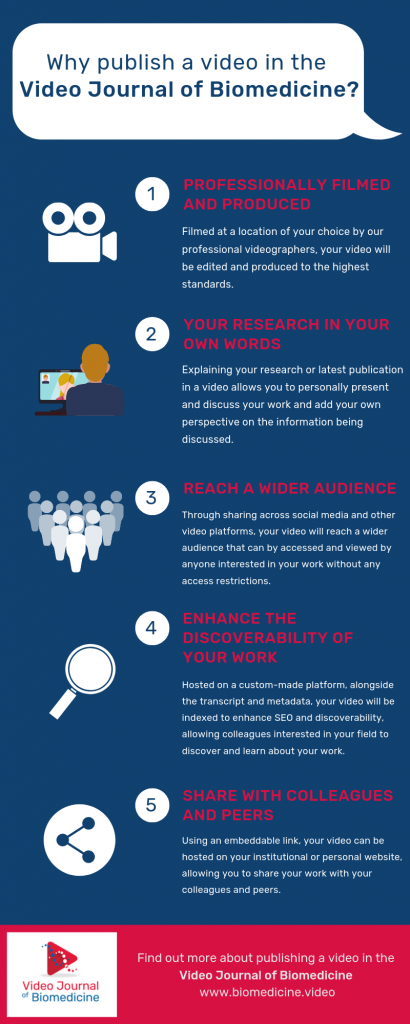FAQs
What is the Video Journal of Biomedicine?
The Video Journal of Biomedicine (VJBM) is a peer-reviewed video platform for researchers to discuss their paper or original research as a video article. Whether it’s a published, peer-reviewed paper, from a Taylor and Francis (T&F) journal or elsewhere, VJBM provides the missing link between research information and its intended audience, including fellow subject specialists, healthcare professionals, researchers with other specialties, students and trainees, or the general public, including patients and caregivers. Through concise, high-quality videos, authors can discuss their research, highlighting its importance, placing it in context and discussing future implications.
Who publishes the VJBM?
The VJBM is published by Taylor and Francis Group.
What types of video does the VJBM publish?
The journal publishes a number of types of video ensuring comprehensive coverage of the latest developments across all fields. For more information please see the Publish section.
What’s the different between a video published the VJBM and a video abstract published alongside an article?
Videos abstracts are short, 2–3-minute videos published against the article, generally filmed using an author’s webcam or other device to provide the reader with a summary of the paper. Readers are referred to the main article for more understanding of the research presented.
Video articles in the VJBM are standalone articles varying from 90 seconds to around 10 minutes in length and provide a platform for authors to discuss their publication or research. The aim is for readers/viewers to gain a comprehensive understanding of the paper or science. As standalone publications, VJBM video articles are published with their own unique DOI.
How are video articles in the VJBM developed?
Videos in the VJBM are either commissioned by the Editor/Publisher or proposed by the author (unsolicited).
Initially a storyboard is developed, summarizing the content of the video, then submitted for peer-review Once review is complete, filming takes place at a time and location of your choice. The video is then produced, either internally (by our in-house video team) or externally.
Who will develop the storyboard?
The storyboard is typically written by the author (with assistance from a co-author or medical writer if required). All authors are given guidelines that includes tips and advice on how to develop the script (and storyboard, if images are to be added). We recognise that writing a script is very different from writing a paper and are able to provide a ‘polishing’ service, free of charge, to ensure the script is engaging and flows well in the video.
We are also able to offer a complete storyboard writing service, which is charged in addition to the video fees and is available upon request.
When it comes to filming, we recommend that rather than following the fully written script, this be developed into bullet form with pointers for the author to follow. This helps ensure the video is more natural and also helps reduce filming time.
Would the storyboard undergo peer review?
Yes, the storyboard undergoes double-anonymized peer-review prior to production.
If a Publication Perspective video discusses an article published by another publisher, is their agreement sought?
In accordance with the guidelines set by ICMJE, we do not need permission from the other publisher, unless images from the original publication are being used. All Publication Perspective articles prominently display the source of original publication, with a link to the original paper. Where figures or tables are used from the original publication, appropriate permissions must be in place and the video article includes the acknowledgement to the original source of publication as stipulated by the original publisher.
Can images be used?
Yes, videos can feature images and we encourage the use of these. Images can be incorporated from the original publication or created bespoke for the video. For more information, see the Publish section.
How long will the filming take?
We expect filming to take no more than 1 hour. We encourage authors to practice as much as possible but understand this might not be feasible. On the day our videographers will make filming as easy and natural as possible, filming in sections, providing prompts and undertaking as many retakes as needed to get the video right.
How long will it take for my video to be published?
Standard publishing timelines are between 14-18 weeks, but an accelerated option is available bringing publication timelines to 7-9 weeks.
Why do you charge fees?
All videos are published on an open access basis so they are freely accessible to all (including researchers, patients and the general public) wanting to understand the latest research via video format. Therefore, to cover the filming, editing & publication costs of each video article, we charge authors fees similar to traditional manuscripts. Where we already have a videographer in place, for instance at a conference or where they are filming at an institution, reduced fees will be offered. We also offer reduced fees at our discretion, for instance for Expert Advisory Panel members or for authors publishing in any T&F journal.
Do all videos have to be filmed by you?
If an author has the capacity to film themselves, we do accept author-produced videos. These must however meet the same standards required for all videos within the VJBM. For more information please visit the Author-produced Videos section of the Publish page.
How do you drive readership to my video?
All videos are shared via VJBM LinkedIn, X and Facebook pages, as well as across Taylor and Francis’ relevant social media accounts. We also encourage authors to help drive readership to the videos themselves and allow authors to embed the videos on their own personal or institution’s website.
For videos related to Taylor and Francis’ journal articles we can host the video in line below the abstract.
